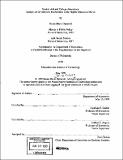Student aid and college attendance : analysis of government intervention in the higher education market
Author(s)
Dynarski, Susan M
DownloadFull printable version (9.658Mb)
Other Contributors
Massachusetts Institute of Technology. Dept. of Economics.
Advisor
Jonathan E. Gruber and Joshua D. Angrist.
Terms of use
Metadata
Show full item recordAbstract
This thesis consists of three essays in public finance and labor economics, with a focus on the economics of higher education. Chapter J estimates the effect of grant aid on college attendance. I exploit the variation in aid created by the elimination of the Social Security Student Benefit Program, which at its peak provided grants totaling $3.3 billion a year to one out of ten college students. I find that $ I 000 ($1997) of grant aid increases educational attainment by about 0.20 years and the probability of attending college by five percentage points. The elasticities of attendance and completed years of college with respect to schooling costs are estimated to be 0.90 to J .0. Given plausible values for the rate of return to a year of college, the aid program examined by this chapter was a cost-effective use of government resources. Chapter 2 explores the response of middle- and upper-income youth to tuition subsidies. Traditionally, federal student aid has focused on low-income students. However, the new federal Hope Scholarship is aimed squarely at middle-and upper-income families. In order to determine how middle-class aid programs will affect college attendance, I examine the impact on college attendance of the Georgia program that is the namesake and inspiration of the federal Hope Scholarship. I find that Georgia's program has increased the college attendance rate of J 8- to J 9-year-olds by 7 .5 to 8.3 percentage points. Among the subset of youth most likely to be eligible for the Georgia program, attendance has risen 10.9 percentage points. The increase is concentrated among Georgia's white students, who have experienced a J 2.3 percentage point rise in their enrollment rate. Black enrollment rates in Georgia are unaffected by the program. Chapter 3, written jointly with Jonathan Gruber, considers the ability of families to smooth consumption in the face of variable income. We find that families are fairly well able to smooth their consumption in the face of variable earnings. Roughly half of this consumption smoothing occurs through offsetting income flows, and, in particular, through the tax system; the other half comes through saving and dissaving. Government transfers play a particularly large role in smoothing consumption against income shocks caused by unemployment.
Description
Thesis (Ph.D.)--Massachusetts Institute of Technology, Dept. of Economics, c1999. Includes bibliographical references.
Date issued
1999Department
Massachusetts Institute of Technology. Department of EconomicsPublisher
Massachusetts Institute of Technology
Keywords
Economics.